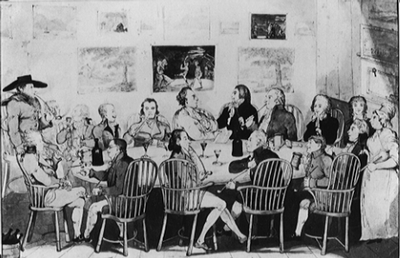Tokens of Revolution
The Propaganda Coins of Thomas Spence and his Contemporaries
Page 2 of 4
Political Tokens
Other issuers appealed to the public, in what was after all a time of war, by espousing patriotic slogans and loyalty to the king. There was even some market in depictions of the beleaguered French royalty, Louis XVI and Marie Antoinette.
.jpg)
(Reverse of a copper halfpenny token engraved by Thomas Wyon for Kempson, late eighteenth century, CM.BI.1937-R)
|
.jpg)
(Reverse of a copper halfpenny token issued by William Williams, London, 1795; Queens' College Collection, CM.QC.3767-R)
|
.jpg)
(Reverse of a copper halfpenny token issued by Peter Skidmore, 1795, depicting Louis XVI and Marie Antoinette of France, 1795, Trinity College Collection, CM.TR.1380-R)
|
.jpg)
(Reverse of a copper halfpenny token issued anonymously, late eighteenth century; Trinity College Collection, CM.TR.1389-R)
|
Revolution and Reform on English Tokens
England avoided revolution after the image of the United States of America and France, but the shared language and shared sea-lanes between it and these new governments meant that the thought and arguments of the revolutionaries were abroad in England too. Particularly prominent as a text for, if not revolution, at least reform was Thomas Paine's The Rights of Man, published in 1791, which defended the rights of the citizenry to rise against a power that would not rule them fairly, and argued for a written constitution and a progressive income tax designed to prevent the emergence of hereditary aristocracies. Paine's book led to him being tried for sedition, but in his absence, as he had already flown to France where he narrowly avoided execution. Trials for sedition in late-eighteenth-century England were not uncommon, and the country could in no way be considered a safe place to speak out against government. Those who continued to express dissent, however, did so not just in printed works and pamphlets, but in metal.

Portrait of Thomas Paine, from Wikimedia Commons
Whether for collectors or for commercial use, the possibilities of a freely-circulating medium, almost impossible to police, were obvious to those who wished to spread propaganda against the state, and although the manufacturers and engravers of tokens would happily take commissions from such parties, the issuers could if necessary acquire the necessary machinery to manufacture them alone. Associations of dissenters who felt themselves particular notable, therefore, or those who wished to celebrate one of the few triumphs against the status quo, often had recourse to this form of advertising in copper.
The danger and isolation of dissent led to a grimly humourous camaraderie that makes these tokens witty, but often hard to grasp. The piece below, for example, mimics the commercial issues that invited the buying public to redeem their tokens for silver at the issuer's business address ("Payable at the premises of..."), but the 'address' given by the reverse design is Newgate Jail, because the four men named had been imprisoned there for sedition the previous year.
.jpg) |
.jpg) |
(Obverse and reverse of a copper halfpenny token engraved by Thomas Wyon and manufactured by Peter Kempson in the name of Henry Symonds, William Winterbotham, James Ridgway and David Holt, 1795, Queens' College Collection, CM.QC.3754-R)
|
The joke hangs on the assumption that the prisoners' names would have been known to anyone who happened to receive the token. This is evidence in itself that the doings of revolutionaries were the subject of common report in London. Two of the men named, Henry Symonds and James Ridgway, had been imprisoned for publishing Paine's book. The etching below, done from life by Richard Newton on a visit to Newgate, shows that if space had permitted many other radicals' names could have been added to the token. The conditions may look comfortable, but two of the men depicted were dead and two more ill with typhoid before the etching was a year old. Symonds and Ridgway appear at the front right of the table, seated.

'Soulagement en Prison, or Comfort in Prison', etching 'drawn from life' by Richard Newton and published on 20 August 1793
Not everyone involved in publishing such literature went to jail, of course, and for the enterprising and socially-minded lawyer there was a name (and a living) to be made in conducting the defence of such radicals. For two such counsels, Thomas Erskine and Vicary Gibbs, the possibility of spreading this reputation (and availability) through tokens also appealed. The below piece is for the most part a celebration of their skill at the bar and the rights of the free man at English law (the banners that the two lawyers hold read 'MAGNA CHARTA' and 'BILL OF RIGHTS'), listing those successfully defended, but it definitely served as advertising too.
.jpg) |
.jpg) |
Obverse and reverse of a copper halfpenny token engraved by Thomas Wyon for Thomas Erskine and Vicary Gibbs, Queens' College Collection, CM.QC.3783-R
|
For some, however, neither the plans of Paine nor the occcasional issue of celebratory tokens went far enough...
Go back | Continue
.jpg)
.jpg)
.jpg)
.jpg)

.jpg)
.jpg)
.jpg)
.jpg)

.jpg)
.jpg)